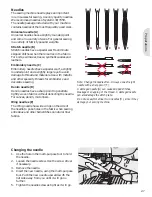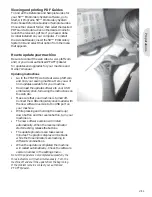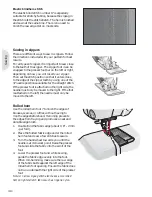
1
2
5
3
4
Press the alternatives button to view
stitch positioning and density
Sewing
Stitch adjustments
Your machine will set the best settings for
each selected stitch. You can make your own
adjustments on the selected stitch.
The setting changes only affect the selected stitch.
Your changed settings will be reset to default when
selecting another stitch. The changed settings
are not automatically saved when turning your
machine off.
The set stitch width and the stitch length are shown
next to the icons for each adjustment. When trying
to exceed minimum or maximum settings for
width and length, a warning sound will be heard.
Note: The numbers are highlighted when the setting is
changed.
Stitch width (1)
Increase or decrease the stitch width using + and -.
Stitch length (2)
Increase or decrease the stitch length using + and
-. If lengthening a zigzag stitch or a decorative
stitch, the entire stitch will be longer. If lengthening
a satin stitch where the density can be adjusted,
the entire stitch will be longer but the density will
remain the same.
Stitch positioning (3)
Press the alternatives button to show the stitch
positioning instead of the stitch width. Use the +
and - buttons to move the stitch to the left or right.
Note: This is only possible when using a stitch that is
narrower than 9 mm. You can decrease the stitch width
to make the stitch narrower if necessary.
Stitch density (4)
Press the alternatives button to show the density
setting instead of the stitch length for satin stitches.
Now the stitch and - buttons adjust the
density. The stitch density does not affect the
actual length of the entire stitch.
Note: This is often used with specialty threads and when
a less dense satin stitch is desired. If you have selected a
buttonhole, the graphic display will by default show the
density setting instead of the stitch length setting.
Thread tension (5)
For the best stitch appearance and durability, make
sure the needle thread tension is correctly adjusted,
i.e. for general sewing, the threads evenly meet
between the two fabric layers.
Your sewing machine electronically sets a thread
tension for the selected stitch. Depending on the
fabric, batting, thread etc, the tension may need to
be adjusted. See page 2:14 for instructions on how
to change the setting manually.
If the bobbin thread is visible on the top side of
the fabric, the needle thread tension is too tight.
Reduce the needle thread tension.
If top thread is visible on the underside of the
fabric, the needle thread tension is too loose.
Increase the needle thread tension.
For decorative stitches and buttonholes, the top
thread should be visible on the underside of the
fabric.
3:2
Содержание CREATIVE 2.0 -
Страница 1: ...Owner s manual ...
Страница 12: ...Preparations ...
Страница 28: ...Sewing ...
Страница 40: ...Sequencing ...
Страница 44: ...Embroidery preparations ...
Страница 48: ...Embroidering ...
Страница 64: ......
Страница 65: ......
Страница 66: ...5D Embroidery Machine Communication CD For personal computer See page 2 10 ...
















































